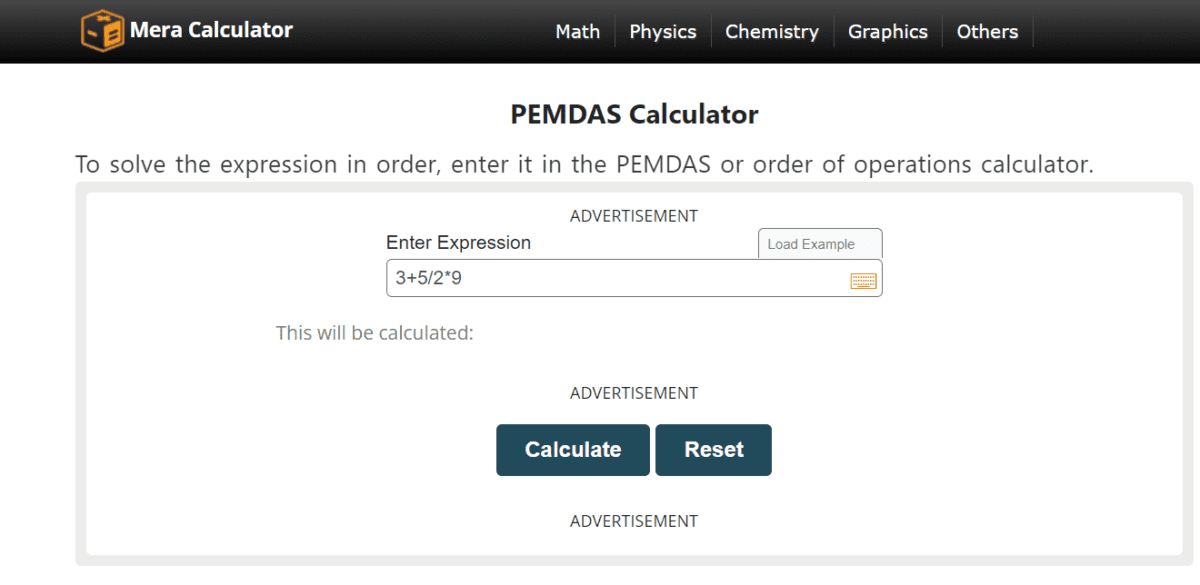How Can an Order of Operations Calculator Help You? The order of operations is widely used in mathematics to calculate the problems of math expression perfectly. This form allows using of a sequence of mathematical symbols such as multiply, divide, addition, & subtraction.
Here are the articles to explain, An introduction to Order of Operations Calculator: Definition, Rules, and Examples
It is usually used all over the world to get a similar result by applying the correct sequence of operations in math expression problems. In this article, we will cover all the general basics of the order of operations calculator along with solved examples.

What is the order of operations?
In mathematics, the order that is used to solve the mathematical expression correctly is known as the order of operations. Also, It provides a sequence of operations that are applied to the math expressions to get the correct result.
The following are two well-known techniques of the order of operations that are frequently used all over the world.
- PEMDAS Rule
- BODMAS Rule
In western countries (United States, United Kingdom, Canada, etc.), the PEMDAS rule is used to solve math expression problems. While in Asian countries (India, Pakistan, Sri Lanka, etc.), the BODMAS rule is used.
Techniques of the order of operations
Here is a brief introduction to both techniques of the order of operations.
(i) PEMDAS Rule
The PEMDAS rule is widely used in western and European countries for solving the expressions of mathematics in a perfect sequence. The PEMDAS stands for:
- P for Parentheses “( )”
- E for Exponent “^”
- M for Multiplication “* or x”
- D for Division “/”
- A for Addition “+”
- S for Subtraction “-”
(ii) BODMAS Rule
The BODMAS rule is widely used in Asian countries for solving the expressions of mathematics in a perfect sequence. The BODMAS stands for:
- B for Brackets (brackets can be braces or parenthesis)
- O for Order of (exponent “^”)
- D for Division “/”
- M for Multiplication “* or x”,
- A for Addition “+”
- S for Subtraction “-”.
How to calculate the order of operations?
The problems of the math expression can be solved easily with the help of the PEMDAS and the BODMAS rules. Below are a few steps to solve the problems of PEMDAS and the BODMAS rules.
- Firstly, evaluate the parenthesis, brackets, and braces that are present in the given math expression. Evaluate the leftmost parenthesis or braces first if there is more than one parenthesis or braces.
- After that evaluate the power, exponent, or order of the terms that are present in the math expression. Evaluate the leftmost exponent or order term first if there is more than one exponent or order.
- Then evaluate the division and multiplication terms of the math expression from left to right.
- Lastly, evaluate the addition and subtraction operations from left to right.
Following are a few examples of the order of operations.
Example 1: By the PEMDAS rule
Evaluate 63 + (112 – 8) * 44 – 40/8 + (43 + 17) – 2 (16 * 4) – 8 by using the PEMDAS rule.
Solution
Step I: Firstly, write the given math expression.
63 + (112 – 8) * 44 – 40/8 + (43 + 17) – 2 (16 * 4) – 8
Step II: Evaluate the parenthesis that is present in the above math expression.
63 + (104) * 44 – 40/8 + (43 + 17) – 2 (16 * 4) – 8
63 + 104 * 44 – 40/8 + (60) – 2 (16 * 4) – 8
Also, 63 + 104 * 44 – 40/8 + 60 – 2 (64) – 8
63 + 104 * 44 – 40/8 + 60 – 128 – 8
Step III: Now evaluate the exponent terms present in the given math expression.
(6 x 6 x 6) + 104 * 44 – 40/8 + 60 – 128 – 8
216 + 104 * 44 – 40/8 + 60 – 128 – 8
216 + 104 * (4 x 4 x 4 x 4) – 40/8 + 60 – 128 – 8
Also, 216 + 104 * 256 – 40/8 + 60 – 128 – 8
Step IV: Now solve the multiplication and division terms from left to right.
216 + 104 * 256 – 40/8 + 60 – 128 – 8
216 + 26624 – 40/8 + 60 – 128 – 8
Also, 216 + 26624 – 5 + 60 – 128 – 8
Step V: Solve the addition and subtraction terms from left to right.
26840 – 5 + 60 – 128 – 8
26835 + 60 – 128 – 8
26895 – 128 – 8
26767 – 8
26759
Step VI: Write the given math expression with the result.
63 + (112 – 8) * 44 – 40/8 + (43 + 17) – 2 (16 * 4) – 8 = 26759
To avoid such a large number of steps to solve the math expression, use a PEMDAS calculator.

Follow the steps below to solve math expressions using a calculator.
Step i: Write the given math expression into the required input field.
Step ii: Click the calculate button below the input field.
Also, Step iii: The result will show in a fraction of a second with steps.
Step iv: Hit the show more button to view the solution with steps.
Example 2: By the BODMAS rule
Solve 12 – (7 + 11) * 6 + 93 – 40/5 – (60 * 3 + 12) + 5 (2 * 14) / 44 by using the BODMAS rule.
Solution
Step I: Firstly, write the given math expression.
12 – (7 + 11) * 6 + 93 – 40/5 – (60 * 3 + 12) + 5 (2 * 14) / 44
Step II: Evaluate the parenthesis present in the given math expression.
12 – (7 + 11) * 6 + 93 – 40/5 – (60 * 3 + 12) + 5 (2 * 14) / 44
12 – (18) * 6 + 93 – 40/5 – (60 * 3 + 12) + 5 (2 * 14) / 44
Also, 12 – 18 * 6 + 93 – 40/5 – (180 + 12) + 5 (2 * 14) / 44
12 – 18 * 6 + 93 – 40/5 – (192) + 5 (2 * 14) / 44
12 – 18 * 6 + 93 – 40/5 – 192 + 5 (28) / 44
Maybe, 12 – 18 * 6 + 93 – 40/5 – 192 + 140 / 44
Step III: Now solve the exponent terms present in the given math expression.
12 – 18 * 6 + 93 – 40/5 – 192 + 140 / 44
12 – 18 * 6 + (9 x 9 x 9) – 40/5 – 192 + 140 / 44
Also, 12 – 18 * 6 + (729) – 40/5 – 192 + 140 / (4 x 4 x 4 x 4)
12 – 18 * 6 + 729 – 40/5 – 192 + 140 / 256
Step IV: Now solve the division and multiplication terms from left to right.
12 – 18 * 6 + 729 – 40/5 – 192 + 140 / 256
12 – 108 + 729 – 40/5 – 192 + 140 / 256
Also, 12 – 108+ 729 – 8 – 192 + 140 / 256
12 – 108+ 729 – 8 – 192 + 0.55
Step V: Solve the addition and subtraction terms from left to right.
12 – 108+ 729 – 8 – 192 + 0.55
-96 + 729 – 8 – 192 + 0.55
633 – 8 – 192 + 0.55
625 – 192 + 0.55
433 + 0.55
433.55
Step VI: Write the given math expression with the result.
12 – (7 + 11) * 6 + 93 – 40/5 – (60 * 3 + 12) + 5 (2 * 14) / 44 = 433.55
Conclusion
Now you are witnessed that solving the problems of math expression by using the PEMDAS and BODMAS is not a difficult task, as well as the order of operations calculator. You have to follow the sequence of operations to get the correct result.




